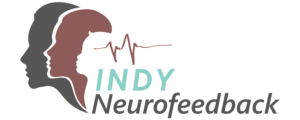My experience with brain mapping at INDY Neurofeedback
 What’s it feel like, exactly, to have your brain mapped at INDY Neurofeedback? I decided I wanted to find out for myself. (Full disclosure, as a blogger for INDY Neurofeedback, I wanted insight into what I was going to be writing about.)
What’s it feel like, exactly, to have your brain mapped at INDY Neurofeedback? I decided I wanted to find out for myself. (Full disclosure, as a blogger for INDY Neurofeedback, I wanted insight into what I was going to be writing about.)
A couple of weeks before my QEEG brain mapping appointment, INDY Neurofeedback sent me an email including several questionnaires. I was asked to complete a Profile, History and Metabolic sections, including questions pertaining to age, general health and wellbeing, smoker or non-smoker, drinker or abstainer, medications taken, that sort of thing.
I was also asked what in particular I wanted to understand about my brain — such as brain clarity, headaches, ruminating, memory, mood swings, poor concentration, anxiety, and/or organizational thinking. Had I been in any car accidents? Had any concussions? Taken any falls involving my head as an adult, or even as a child?
Since most of my prior trips to a health professional have not involved a lot of questions about brain wellbeing, it was interesting to – no pun intended – wrap my head around this. What, if anything, was I concerned about my brain health? What self-behaviors did I wonder about? What answers about how I think, react, emote, remember, and/or obsess about might I be looking for? Talk about being circumspect! I took my time with my answers (about 30-40 minutes), and sent back the questionnaires.
When I went to meet Leanne O’Neil over a week later, I wore comfortable clothes, and arrived very curious. Here’s what I learned right off the bat:
- I needn’t have worried about fixing my hair for our meeting. Something akin to a bathing cap was comfortably placed over my head, rendering useless any styling techniques I might have employed.
- Next, Leanne put a small dab of clear goo on several places on my head, and then attached several flexible wires to the cap. No wires stuck into me. Nothing itched. It was all very comfortable.
- I sat in a softly lit room on a comfortable chair, facing forward. Leanne sat to my left, looking down at her computer monitor. She had placed a square sheet of paper with a black circle in the middle on a shelf a few feet away from me. She asked me to stare at the circle, blinking as little as possible, as she ascertained where various activity centers of my brain were.
- She moved a few wires. I repeated the circle stare several times. I began to get better at not blinking.
- Most frequently asked new client question: “Can you see what I’m thinking?” Answer: No. The scanner only reads brain region activity, nothing more.
- “Can you feel or sense the scan?” Another no. I heard Leanne typing up the numbers she saw on her screen. I neither heard nor felt anything else.
- “Is it like a lie detector? Will I be asked any compromising questions?” Not at all. The process is very quiet. Just a few instructions about relaxing and eye blinking as Leanne maps the areas of your brain.
The full mapping process took about an hour, plus another 30 minutes or so back in Leanne’s office to talk about the results. (Plus about 10 minutes between those time allotments to wipe a little goo from your scalp and fluff up your hair.)
Back in Leanne’s office, I sat across from her. She had about six pages of printed out results, including several easy to understand bar graphs and pictures showing the primary areas of my brain, and what each area was responsible for.
Leanne began the discussion with something like, “Here are your brain mapping results. Most likely, you already know most of what these results substantiate. There really shouldn’t be any surprises here. This just gives you concrete terms with which to understand what you are already aware of.”
I saw how each area of my brain was performing, taking clues from the graphs and print outs in front of me. Some areas were underperforming (dysregulated brainwave patterns) and others were more regulated. Since I am a question-asker, I asked quite a few. But someone else could have quietly listened, and taken it all in without a discussion, and that would have been fine, too.
I left Leanne’s office with my paperwork, knowing my results were confidential. INDY Neurofeedback follows all HIPAA regulations.
What might the next steps be? Well, the baseline scan numbers were right in my hands. If I wanted to strengthen or re-train any dysregulated areas of my brain, I could set up a series of sessions called biofeedback or neurofeedback. With the help of a brain scan and working with a trained professional, I would be able to help whatever areas of my brain I chose, such as strengthening memory, or re-directing pain signals, or helping regions affected by stroke or injury. The list is virtually endless, and it is guided by the patient herself. I would be able to see the results of any improvement I made with my next scan.
I have to say, I left fascinated. And intrigued to learn more.
If this sounds interesting to you for yourself or on behalf of a family member, it’s very easy to contact Leanne O’Neil with your questions or concerns. (P.S. She is real easy to talk to.)
